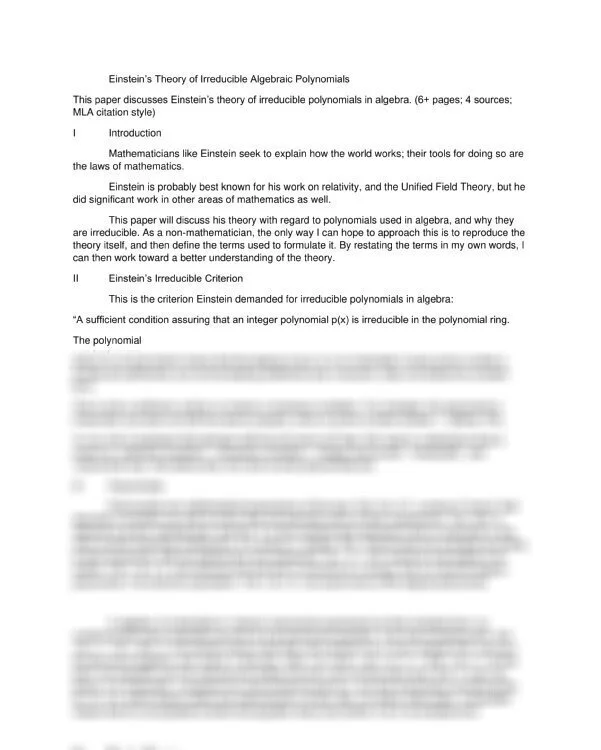Einstein’s Theory of Irreducible Algebraic Polynomials
Einstein’s Theory of Irreducible Algebraic Polynomials
(+ (-a) (-a), (1*2)*3 (2 (2)*3 (2*3) (2*4) (2, (3 (3x (6+ (Barile, (I (In (Stapel, (Weisstein, (Zero (a (a*b) (a*b)*c (a*c) (all (b (b*a) (b+c)*a (below) (c*a). (integers) (though (which (whole (x2 (“Ring,” *), + +1 +1.” +1/x, +1” +2 +2x +2”; +3,” +3x +4x2) , . 0 0. 0; 0” 1(2*3) 1(6) 1). 1*(2*3). 1.” 12, 14 14; 1999-2003. 2 2*(3 2*(7) 2, 2. 2000-2003. 2003. 22, 2x 2x.) 3 3) 32, 372, 3”. 4 4) 4). 4. 4x2 5 5x 6 6. 6; 7 7x2” 8 9. 9; = =3 A Accessed: Algebraic An And As At Back Barile, But By Conclusion Criterion Criterion.” Dated: Einstein Einstein’s Elizabeth. Eric. Example: Field Finally, First, For From He Here’s How I II III IV If In Introduction Irreducibility Irreducible It I’ve Let MLA Margherita. Mathematicians Mathworld Mathworld. No Now Now, Oct PG). Polynomials Purplemath Recall, References S S, Secondly, Solving: Stapel, That The Then Theory Theory, This To Unfortunately, Unified V We Weisstein, Z, [Website]. a a*(b*c). a*(b+c) a, a. about above above? according action added addition against algebra, algebra. algebra: all also always an and and, answer anx, any anything approach are are, are. areas arranged as aside, associativity,” associativity” assuring at away); b b) b, back basically be because become before beginning, begins belonging best better between beyond binary bit both but by c c). can cannot can’t case, circular, citation coefficient coefficient; coefficients coefficients, combining come commutativity” complex computations condition condition, condition,” condition. condition: conditions: condition” condition”, considered constant constant; continues correct could couple coupled course criterion decimal define defining degree demanded describe desirable did digit discuss discusses distributivity, divide divided) divides does doesn’t doing done down easier: element eliminating end ending ends equal equation equation. equations even, even. even.” every example example, example? except exists explain exponent exponents, expression expressions expressions. fact factor fifth-degree finally finally, first first, first: five following for form, form. form: formal formulate four from fulfil further further, further; general, given go guarantee guarantees had has hassles have he held help. hence here, he’s highest his hold hope hopeless! how http://mathworld.wolfram.com/Condition.html http://mathworld.wolfram.com/EisensteinsIrreducibilityCriterion.html http://mathworld.wolfram.com/Ring.html http://www.purplemath.com/modules/polydefs.htm i idea identical.) identity” if improvement.) in indicating integer integers integers. inverse,” irreducible irreducible, irreducible. is is, it it, it. its itself itself, it’s know known laws leading leave let’s like look looks make math mathematical mathematics mathematics. matter me me, means meant meets mention modification; modify moreover, much multiplication must my n n) name. necessary need negative no non-mathematician, not now number number, number.) numbers numbers); numbers, numbers. o of often on one one. one; only operations. operators, opposite or other own p p(x) pages; paper perhaps place point, polynomial polynomial. polynomials polynomials. polynomial” polynomial”, positive positive); possible postulating prime probably problem, properties property, prove put rate, rearranged reduce reduced referred regard relate relativity, reproduce requirement restating result results right ring ring. ring.” ring” ring”. same same: satisfies satisfy says second-degree see seek seem series set shaky significant simpler simplest since six so solve solve; solving some something sources; specific square, squared state statement step, stronger style) such sufficient sufficient, sufficient” sums suppose symbol tell term term. term; terms terms, terms; term’s term” test than that that, that; the their them then theorem theorem, theorem. theory theory. there therefore they they’re things think this this: three through thus time to together together, together: tools toward true true, true. tw two type understand understanding until us use used uses usually very way we well, well. we’d what whatever), when where wherein which which, why will wish with within won’t words, work worked works works; world would wouldn’t written x x, x2 – –x) –x2 –x” “(2x2 “2x “2x2 “2” “3x2 “3x2” “5x2 “7x2 “7x5 “A “Condition.” “Einstein’s “Polynomials.” “Ring.” “S” “a “additive “ai” “an “condition” “integer “irreducible” “irreducible”, “leading “left “multiplicative “necessary “necessary” “plug” “polynomial “reduce” “solve” “sufficient “sufficient” “terms” “x” “…the
Einstein’s Theory of Irreducible Algebraic Polynomials
This paper discusses Einstein’s theory of irreducible polynomials in algebra. (6+ pages; 4 sources; MLA citation style)
I Introduction
Mathematicians like Einstein seek to explain how the world works; their tools for doing so are the laws of mathematics.
Einstein is probably best known for his work on relativity, and the Unified Field Theory, but he did significant work in other areas of mathematics as well.
This paper will discuss his theory with regard to polynomials used in algebra, and why they are irreducible. As a non-mathematician, the only way I can hope to approach this is to reproduce the theory itself, and then define the terms used to formulate it. By restating the terms in my own words, I can then work toward a better understanding of the theory.
II Einstein’s Irreducible Criterion
This is the criterion Einstein demanded for irreducible polynomials in algebra:
“A sufficient condition assuring that an integer polynomial p(x) is irreducible in the polynomial ring.
The polynomial
where for all and (which means that the degree of p(x) is n) is irreducible if some prime number p divides all coefficients, but not the leading coefficient and, moreover, does not divide the constant term.
This is only a sufficient, and by no means a necessary condition. For example, the polynomial is irreducible, but does not fulfil the above property, since no prime number divides 1.” (Barile, PG).
